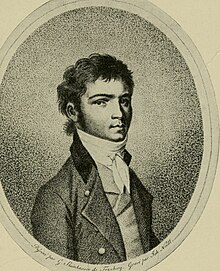Piano Sonata No. 4 (Beethoven)
| Piano Sonata No. 4 | |
|---|---|
| by Ludwig van Beethoven | |
 Beethoven in 1796; designed by G. Stainhauser; engraving by Johann Josef Neidl, executed for the publisher Artaria | |
| Key | E-flat major |
| Opus | 7 |
| Style | Classical period |
| Form | Piano sonata |
| Composed | 1796 |
| Dedication | Babette, Countess of Keglević |
| Published | 1796, Vienna |
| Publisher | Artaria |
| Duration | 28 minutes |
| Movements | 4 |
| Audio samples | |
I. Allegro molto con brio (7:30) | |
II. Largo con gran espressione (9:34) | |
III. Allegro (4:55) | |
IV. Rondo (Poco allegretto e grazioso) (6:11) Performed by Artur Schnabel in 1932 | |
Ludwig van Beethoven's Piano Sonata No. 4, in E♭ major, Op. 7, sometimes nicknamed the Grand Sonata, was written in November 1796 and dedicated to his student Babette, the Countess Keglević.[1][2] The sonata was composed during Beethoven's visit to the Keglevich Palace.[3] Beethoven named it Great Sonata, because it was published alone, which was unusual for the time.[citation needed]
Along with the Hammerklavier Sonata, it is one of the longest piano sonatas that Beethoven composed.[4][1] A typical performance lasts about 28 minutes.
Structure
The sonata is laid out in four movements:
- Allegro molto e con brio, 6
8 (E-flat major) - Largo, con gran espressione, 3
4 (C major) - Allegro, 3
4 (E-flat major - Trio in E-flat minor) - Rondo: Poco allegretto e grazioso, 2
4 (E-flat major)
I. Allegro molto e con brio

The first movement is in sonata form.[5]
II. Largo con gran espressione

The second movement is in ternary form.[5]
III. Allegro

The third movement is in scherzo and trio form.[5]
IV. Rondo: Poco allegretto e grazioso

The fourth movement is in rondo form.[5] This movement of the sonata in particular was featured in the documentary Note by Note: The Making of Steinway L1037
References
- ^ a b McCallum 2007, p. 8
- ^ Hewitt 2006, p. 7
- ^ Huizing, Jan Marisse (2021). Ludwig Van Beethoven : The Piano Sonatas; History, Notation, Interpretation. New Haven: Yale University Press. p. 6. ISBN 9780300262742.
- ^ Hewitt 2006, p. 6
- ^ a b c d "Beethoven: Piano Sonata No.4 in E♭ major Analysis".
- Sources
- Hewitt, Angela (2006). Liner Notes to Beethoven: Piano Sonatas Opp 10/3, 7 & 57 (PDF) (CD). Hyperion Records. CDA67518.
- McCallum, Peter (2007). "Program notes - Gerhard Oppitz performs Beethoven" (PDF). Sydney Symphony Orchestra. Archived from the original (PDF) on 2015-03-21. Retrieved 2016-06-21.
External links
- Piano Sonata No. 4: Scores at the International Music Score Library Project
- "The Guardian UK Culture Podcast Culture Andras Schiff lecture recital: Beethoven's Piano Sonata Op 7". TheGuardian.com. 1 Nov 2006. Retrieved 20 Aug 2023.
- A direct link to its audio file: A lecture recital by András Schiff on Beethoven's piano sonata, Op. 7
- For a public domain recording of this sonata visit Musopen
- "Op. 7 - The Beethoven Sonatas". World of Beethoven.com. 5 September 2009. - Discussion and analysis
- "Piano Sonata No.4, Op. 7: Creation History & Music Criticism". Raptus Association. Archived from the original on 2017-03-19. Retrieved 2016-06-20.
- European Archive Copyright-free LP recording of the Sonata no.4 op.7 in E♭ major by Hugo Steurer, piano at the European Archive (for non-American viewers only).
